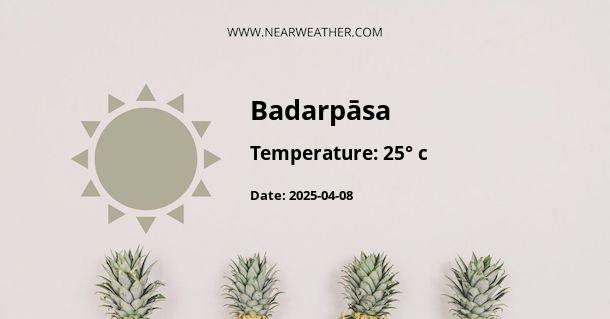Climate and Weather in Badarpāsa, Bangladesh
Located in Bangladesh, Badarpāsa experiences a tropical monsoon climate characterized by hot and humid summers and mild winters. The region is influenced by the Indian Ocean and the Bay of Bengal, which play a significant role in shaping its weather patterns throughout the year.
Temperature
The average annual temperature in Badarpāsa is around 26 degrees Celsius (78 degrees Fahrenheit). The summers, which last from March to June, are extremely hot with temperatures reaching up to 40 degrees Celsius (104 degrees Fahrenheit) during the peak months of April and May. The humidity levels are also high, making the weather feel even hotter.
Winter in Badarpāsa, from November to February, is relatively mild with temperatures ranging from 15 to 25 degrees Celsius (59 to 77 degrees Fahrenheit). The evenings and early mornings can be cooler, dropping to around 10 to 15 degrees Celsius (50 to 59 degrees Fahrenheit). However, it is important to note that the region does not experience extreme cold temperatures.
Rainfall
Badarpāsa receives a significant amount of rainfall throughout the year due to its monsoon climate. The rainy season, which lasts from June to October, is characterized by heavy downpours and occasional thunderstorms. The region experiences an average annual rainfall of around 2,500 to 3,000 millimeters (98 to 118 inches).
The peak of the monsoon season occurs in July and August when the region receives the highest amount of rainfall. During this time, it is common to experience continuous rain for several days. The rainfall plays a crucial role in supporting the region's agriculture, as it provides water for irrigation and helps in the growth of crops.
Wind Patterns
Badarpāsa is influenced by both the southwest and northeast monsoons. From June to September, the southwest monsoon brings moist air from the Indian Ocean, resulting in heavy rainfall. In contrast, the northeast monsoon, which occurs from November to February, brings drier air from the Himalayas and causes a decrease in rainfall.
The wind patterns in Badarpāsa also play a role in moderating the temperatures. The sea breeze from the Bay of Bengal during the day helps to cool down the region, while the land breeze at night brings warmer air from inland areas.
Climate Change Impact
Like many other regions around the world, Badarpāsa is also experiencing the impacts of climate change. Rising temperatures, changing rainfall patterns, and increased frequency of extreme weather events are some of the noticeable effects.
The rise in temperatures can lead to heatwaves, affecting the health and well-being of the residents. Additionally, the changing rainfall patterns can lead to both droughts and floods, impacting agriculture and livelihoods. It is crucial for the region to adapt to these changes and implement sustainable practices to mitigate the impact of climate change.
Conclusion
Badarpāsa, Bangladesh, experiences a tropical monsoon climate with hot and humid summers and mild winters. The region receives a significant amount of rainfall throughout the year, with the peak occurring during the monsoon season from June to October. The wind patterns and proximity to the Indian Ocean and the Bay of Bengal influence the weather in Badarpāsa. However, it is important to note that climate change is affecting the region, leading to rising temperatures and changing rainfall patterns. Adapting to these changes is crucial for the well-being and sustainability of the region.
A - Badarpāsa's Latitude is 23.216669 & Longitude is 90.050003.
A - Weather in Badarpāsa is 23° today.
A - Climate Conditions in Badarpāsa shows clear sky today.
A - Humidity in Badarpāsa is 31% today.
A - Wind speed in Badarpāsa is 13.03 km/h, flowing at 277° wind direction. today.
